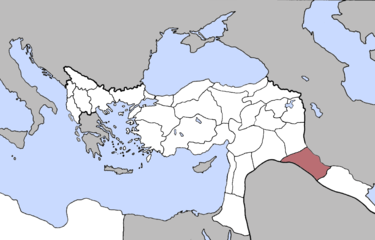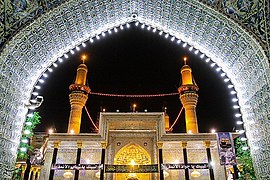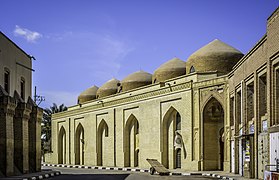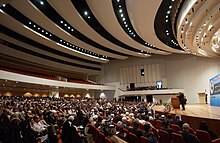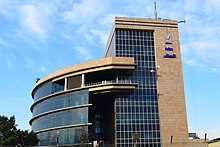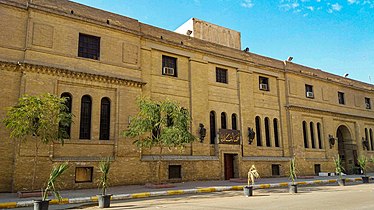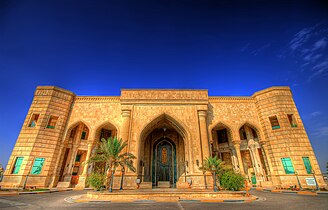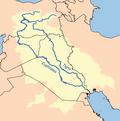89 Official Neighbourhoods
In 762 AD, Baghdad was founded as the capital of the Abbasid Caliphate, and became its most notable major development project. Within a short time, it evolved into a significant cultural and intellectual center of the Muslim world. This, in addition to housing several key academic institutions, including the House of Wisdom, as well as a multi-ethnic and multi-religious environment, garnered it a worldwide reputation as the "Center of Learning". For much of the Abbasid era, during the Islamic Golden Age, Baghdad was the largest city in the world. Its population peaked at more than one million people. The city was largely destroyed at the hands of the Mongol Empire in 1258, resulting in a decline that would linger through many centuries due to frequent plagues and multiple successive empires, such as the Mesopotamian Mamluk Sultanate and the Ottoman Empire, until the World War I.
The city served as capital of the former British Mandate of Mesopotamia. With the recognition of Iraq as an independent monarchical state in 1932, Baghdad gradually regained some of its former prominence as a significant center of Arab culture. Baghdad has faced severe infrastructural damage due to the Iraq War, which began with the United States-led invasion of Iraq, the subsequent insurgency and renewed war, resulting in a substantial loss of cultural heritage and historical artifacts. During this period, it had one of the highest rates of terrorist attacks in the world. However, terrorist attacks have gradually been on the decline since the territorial defeat of the Islamic State militant group in Iraq in 2017, and are very rare now.
A major center of Islamic history, the city is known for its numerous historic mosques. It includes museums such as the Iraq Museum, Baghdadi Museum and Abd al-Karim Qasim Museum. Baghdad is also nicknamed as "City of Palaces", as its home to numerous palaces such as Abbasid Palace, Radwaniyah Palace and Al-Faw Palace. Previously being multi-religious city, the city is also many churches, mandis and synagogues. Through its airport, Baghdad is known as the "Gateway of Iraq".
Name
The name Baghdad is pre-Islamic, and its origin is disputed. The site where the city of Baghdad developed has been populated for millennia. Archaeological evidence shows that the site of Baghdad was occupied by various peoples long before the Arab conquest of Mesopotamia in 637 CE, and several ancient empires had capitals located in the surrounding area.
Arab authors, realizing the pre-Islamic origins of Baghdad's name, generally looked for its roots in Middle Persian. They suggested various meanings, the most common of which was "bestowed by God". Modern scholars generally tend to favor this etymology, which views the word as a Persian compound of bagh (![]() ) "god" and dād (
) "god" and dād (![]() ) "given". In Old Persian the first element can be traced to boghu and is related to Indo-Iranian bhag and Slavic bog "god." A similar term in Middle Persian is the name Mithradāt (Mehrdad in New Persian), known in English by its borrowed Hellenistic form Mithridates, meaning "Given by Mithra" (dāt is the more archaic form of dād, related to Sanskrit dāt, Latin dat and English donor), ultimately borrowed from Persian Mehrdad. There are a number of other locations whose names are compounds of the Middle Persian word bagh, including Baghlan and Bagram in Afghanistan, Baghshan in Iran itself, and Baghdati in Georgia, which likely share the same etymological Iranic origins.
) "given". In Old Persian the first element can be traced to boghu and is related to Indo-Iranian bhag and Slavic bog "god." A similar term in Middle Persian is the name Mithradāt (Mehrdad in New Persian), known in English by its borrowed Hellenistic form Mithridates, meaning "Given by Mithra" (dāt is the more archaic form of dād, related to Sanskrit dāt, Latin dat and English donor), ultimately borrowed from Persian Mehrdad. There are a number of other locations whose names are compounds of the Middle Persian word bagh, including Baghlan and Bagram in Afghanistan, Baghshan in Iran itself, and Baghdati in Georgia, which likely share the same etymological Iranic origins.
Other authors have suggested older origins for the name, in particular the name Bagdadu or Hudadu that existed in Old Babylonian (spelled with a sign that can represent both bag and hu), and the Jewish Babylonian Aramaic name of a place called Baghdatha (בגדתא). Some scholars suggested Aramaic derivations.
Another view, suggested by Christophe Wall-Romana, is that name of "Baghdad" is derived from "Akkad", as the cuneiform logogram for Akkad (𒀀𒂵𒉈𒆠) is pronounced "a-ga-dè" ("Agade") and its resemblance to "Baghdad" is compelling.
When the Abbasid caliph al-Mansur founded a completely new city for his capital, he chose the name "City of Peace" (Arabic: مدینة السلام, romanized: Madīnat as-Salām), which now refers to the Round City of Baghdad proper. This was the official name on coins, weights, and other official usage, although the common people continued to use the old name. By the 11th century, Baghdad became almost the exclusive name for the world-renowned metropolis.
Christophe Wall-Romana has suggested that al-Mansur's choice to found his "new city" at Baghdad because of its strategic location was the same criteria which influenced Sargon's choice to found the original city of Akkad in the exact same location.
History
Foundation

After the fall of the Umayyads, the first Muslim dynasty, the victorious Abbasid rulers wanted their own capital from which they could rule. They chose a site north of the Sassanid capital of Ctesiphon, and on 30 July 762 the caliph Al-Mansur commissioned the construction of the city. It was built under the guidance of the Iranian Barmakids. Mansur believed that Baghdad was the perfect city to be the capital of the Islamic Empire under the Abbasids. The Muslim historian al-Tabari reported an ancient prediction by Christian monks that a lord named Miklas would one day build a spectacular city around the area of Baghdad. When al-Mansur heard the story, he became very joyful, for legend has it, he was called Miklas as a child. Mansur loved the site so much he is quoted saying: "This is indeed the city that I am to found, where I am to live, and where my descendants will reign afterward".

The city's growth was helped by its excellent location, based on at least two factors: it had control over strategic and trading routes along the Tigris, and it had an abundance of water in a dry climate. Water exists on both the north and south ends of the city, allowing all households to have a plentiful supply, which was quite uncommon during this time. The city of Baghdad quickly became so large that it had to be divided into three judicial districts: Madinat al-Mansur (the Round City), al-Sharqiyya (al-Karkh) and Askar al-Mahdi (on the West Bank). Al-Mansur also planned out al-Karkh district so that he could separate the markets from the Round City in order to keep the turbulent populace away from the Round City to ensure that the gates would not be open at night for markets. Over time, the markets became diverse and a home to merchants and craftsmen. Officials with the title of “Muhtasib” were hired to look after markets to prevent cheating and check the weighs and measures of stocks.
Baghdad eclipsed Ctesiphon, the capital of the Sassanians, which was located some 30 km (19 mi) to the southeast. Today, all that remains of Ctesiphon is the shrine town of Salman Pak, just to the south of Greater Baghdad which is where Salman the Persian is believed to have been buried. Ctesiphon itself had replaced and absorbed Seleucia, the first capital of the Seleucid Empire, which had earlier replaced the city of Babylon.
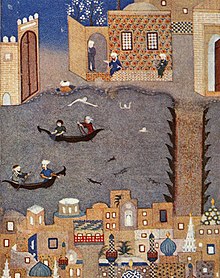
According to the traveler Ibn Battuta, Baghdad was one of the largest cities, not including the damage it has received. The residents are mostly Hanbalis. Baghdad is also home to the grave of Abu Hanifa where there is a cell and a mosque above it. The Sultan of Baghdad, Abu Said Bahadur Khan, was a Tatar king who embraced Islam.
In its early years, the city was known as a deliberate reminder of an expression in the Qur'an, when it refers to Paradise. It took four years to build (764–768). Mansur assembled engineers, surveyors, and art constructionists from around the world to come together and draw up plans for the city. Over 100,000 construction workers came to survey the plans; many were distributed salaries to start the building of the city. July was chosen as the starting time because two astrologers, Naubakht Ahvazi, an Iranian Zoroastrian, and Mashallah, an Iranian Jew, believed that the city should be built under the sign of the lion, Leo. Leo is associated with fire and symbolizes productivity, pride, and expansion and Leo's connection symbolically to Mithra.
The bricks used to make the city were 18 in (460 mm) on all four sides. Abu Hanifah was the counter of the bricks and he developed a canal, which brought water to the work site for both human consumption and the manufacture of the bricks. Marble was also used to make buildings throughout the city, and marble steps led down to the river's edge.


The basic framework of the city consists of two large semicircles about 19 km (12 mi) in diameter. The inner city connecting them was designed as a circle about 2 km (1.2 mi) in diameter, leading it to be known as the "Round City". The original design shows a single ring of residential and commercial structures along the inside of the city walls, but the final construction added another ring inside the first. Within the city there were many parks, gardens, villas, and promenades. There was a large sanitation department, many fountains and public baths, and unlike contemporary European cities at the time, streets were frequently washed free of debris and trash. In fact, by the time of Harun al-Rashid, Baghdad had a few thousand hammams. These baths increased public hygiene and served as a way for the religious to perform ablutions as prescribed by Islam. Moreover, entry fees were usually so low that almost everyone could afford them. In the center of the city lay the mosque, as well as headquarters for guards. The purpose or use of the remaining space in the center is unknown. The circular design of the city was a direct reflection of the traditional Near Eastern urban design. The Sasanian city of Gur in Fars, built 500 years before Baghdad, is nearly identical in its general circular design, radiating avenues, and the government buildings and temples at the center of the city. Much earlier, circular cities had existed in the Syro-Mesopotamian heartland, one of the better-known examples being Mari, while Tell Chuera and Tell al-Rawda also provide examples of this type of urban planning existing in bronze age Syria. This style of urban planning contrasted with Ancient Greek and Roman urban planning, in which cities are designed as squares or rectangles with streets intersecting each other at right angles.
Baghdad was a hectic city during the day and had many attractions at night. There were cabarets and taverns, halls for backgammon and chess, live plays, concerts, and acrobats. On street corners, storytellers engaged crowds with tales such as those later told in Arabian Nights. Storytelling became a profession called "al-Qaskhun" which survived until the modern era.

The four surrounding walls of Baghdad were named Kufa, Basra, Khurasan, and Syria; named because their gates pointed in the directions of these destinations. The distance between these gates was a little less than 2.4 km (1.5 mi). Each gate had double doors that were made of iron; the doors were so heavy it took several men to open and close them. The wall itself was about 44 m thick at the base and about 12 m thick at the top. Also, the wall was 30 m high, which included merlons, a solid part of an embattled parapet usually pierced by embrasures. This wall was surrounded by another wall with a thickness of 50 m. The second wall had towers and rounded merlons, which surrounded the towers. This outer wall was protected by a solid glacis, which is made out of bricks and quicklime. Beyond the outer wall was a water-filled moat.
The Golden Gate Palace, the residence of the caliph and his family, was in the heart of Baghdad, in the central square. In the central part of the building, there was a green dome that was 39m high. Surrounding the palace was an esplanade, a waterside building, in which only the caliph could come riding on horseback. In addition, the palace was near other mansions and officer's residences. Near the Gate of Syria, a building served as the home for the guards. It was made of brick and marble. The palace governor lived in the latter part of the building and the commander of the guards in the front. In 813, after the death of caliph Al-Amin, the palace was no longer used as the home for the caliph and his family. The roundness points to the fact that it was based on Arabic script. The two designers who were hired by Al-Mansur to plan the city's design were Naubakht, a Zoroastrian who also determined that the date of the foundation of the city would be astrologically auspicious, and Mashallah, a Jew from Khorasan, Iran.
Center of learning (8th–9th centuries)
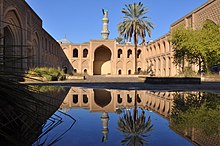
Within a generation of its founding, Baghdad became a hub of learning and commerce. The city flourished into an unrivaled intellectual center of science, medicine, philosophy, and education, especially with the Abbasid translation movement began under the second caliph Al-Mansur and thrived under the seventh caliph Al-Ma'mun. Baytul-Hikmah or the "House of Wisdom" was among the most well known academies, and had the largest selection of books in the world by the middle of the 9th century. Notable scholars based in Baghdad during this time include translator Hunayn ibn Ishaq, mathematician al-Khwarizmi, and philosopher Al-Kindi. Although Arabic was used as the international language of science, the scholarship involved not only Arabs, but also Persians, Syriacs, Nestorians, Jews, Arab Christians, and people from other ethnic and religious groups native to the region. These are considered among the fundamental elements that contributed to the flourishing of scholarship in the Medieval Islamic world. Baghdad was also a significant center of Islamic religious learning, with Al-Jahiz contributing to the formation of Mu'tazili theology, as well as Al-Tabari culminating in the scholarship on the Quranic exegesis. Baghdad is likely to have been the largest city in the world from shortly after its foundation until the 930s, when it tied with Córdoba. Several estimates suggest that the city contained over a million inhabitants at its peak. Many of the One Thousand and One Nights tales, widely known as the Arabian Nights, are set in Baghdad during this period. It would surpass even Constantinople in prosperity and size.

Among the notable features of Baghdad during this period were its exceptional libraries. Many of the Abbasid caliphs were patrons of learning and enjoyed collecting both ancient and contemporary literature. Although some of the princes of the previous Umayyad dynasty had begun to gather and translate Greek scientific literature, the Abbasids were the first to foster Greek learning on a large scale. Many of these libraries were private collections intended only for the use of the owners and their immediate friends, but the libraries of the caliphs and other officials soon took on a public or a semi-public character. Four great libraries were established in Baghdad during this period. The earliest was that of the famous Al-Ma'mun, who was caliph from 813 to 833. Another was established by Sabur ibn Ardashir in 991 or 993 for the literary men and scholars who frequented his academy. This second library was plundered and burned by the Seljuks only seventy years after it was established. This was a good example of the sort of library built up out of the needs and interests of a literary society. The last two were examples of madrasa or theological college libraries. The Nezamiyeh was founded by the Persian Nizam al-Mulk, who was vizier of two early Seljuk sultans. It continued to operate even after the coming of the Mongols in 1258. The Mustansiriyah madrasa, which owned an exceedingly rich library, was founded by Al-Mustansir, the second last Abbasid caliph, who died in 1242. This would prove to be the last great library built by the caliphs of Baghdad.
Stagnation and invasions (10th–16th centuries)
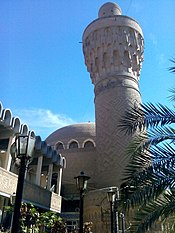

By the 10th century, the city's population was between 1.2 million and 2 million. Baghdad's early meteoric growth eventually slowed due to troubles within the Caliphate, including relocations of the capital to Samarra (during 808–819 and 836–892), the loss of the western and easternmost provinces, and periods of political domination by the Iranian Buwayhids (945–1055) and Seljuk Turks (1055–1135). The Seljuks were a clan of the Oghuz Turks from Central Asia that converted to the Sunni branch of Islam. In 1040, they destroyed the Ghaznavids, taking over their land and in 1055, Tughril Beg, the leader of the Seljuks, took over Baghdad. The Seljuks expelled the Buyid dynasty of Shiites that had ruled for some time and took over power and control of Baghdad. They ruled as Sultans in the name of the Abbasid caliphs (they saw themselves as being part of the Abbasid regime). Tughril Beg saw himself as the protector of the Abbasid Caliphs.
Baghdad was captured in 1394, 1534, 1623 and 1638. The city has been sieged in 812, 865, 946, 1157, 1258 and in 1393 and 1401, by Tamerlane. In 1058, Baghdad was captured by the Fatimids under the Turkish general Abu'l-Ḥārith Arslān al-Basasiri, an adherent of the Ismailis along with the 'Uqaylid Quraysh. Not long before the arrival of the Saljuqs in Baghdad, al-Basasiri petitioned to the Fatimid Imam-Caliph al-Mustansir to support him in conquering Baghdad on the Ismaili Imam's behalf. It has recently come to light that the famed Fatimid da'i, al-Mu'ayyad al-Shirazi, had a direct role in supporting al-Basasiri and helped the general to succeed in taking Mawṣil, Wāsit and Kufa. Soon after, by December 1058, a Shi'i adhān (call to prayer) was implemented in Baghdad and a khutbah (sermon) was delivered in the name of the Fatimid Imam-Caliph. Despite his Shi'i inclinations, Al-Basasiri received support from Sunnis and Shi'is alike, for whom opposition to the Saljuq power was a common factor.

On 10 February 1258, Baghdad was captured by the Mongols led by Hulegu, a grandson of Chingiz Khan (Genghis Khan), during the siege of Baghdad. Many quarters were ruined by fire, siege, or looting. The Mongols massacred most of the city's inhabitants, including the caliph Al-Musta'sim, and destroyed large sections of the city. The canals and dykes forming the city's irrigation system were also destroyed. During this time, in Baghdad, Christians and Shia were tolerated, while Sunnis were treated as enemies. The sack of Baghdad put an end to the Abbasid Caliphate. It has been argued that this marked an end to the Islamic Golden Age and served a blow from which Islamic civilization never fully recovered.

At this point, Baghdad was ruled by the Ilkhanate, a breakaway state of the Mongol Empire, ruling from Iran. In August 1393, Baghdad was occupied by the Central Asian Turkic conqueror Timur ("Tamerlane"), by marching there in only eight days from Shiraz. Sultan Ahmad Jalayir fled to Syria, where the Mamluk Sultan Barquq protected him and killed Timur's envoys. Timur left the Sarbadar prince Khwaja Mas'ud to govern Baghdad, but he was driven out when Ahmad Jalayir returned.
In 1401, Baghdad was again sacked, by Timur. When his forces took Baghdad, he spared almost no one, and ordered that each of his soldiers bring back two severed human heads. Baghdad became a provincial capital controlled by the Mongol Jalayirid (1400–1411), Turkic Kara Koyunlu (1411–1469), Turkic Ak Koyunlu (1469–1508), and the Iranian Safavid (1508–1534) dynasties.
Ottoman and mamluks (16th–19th centuries)
In 1534, Baghdad was captured by the Ottoman Empire. Under the Ottomans, Baghdad continued into a period of decline, partially as a result of the enmity between its rulers and Iranian Safavids, which did not accept the Sunni control of the city. Between 1623 and 1638, it returned to Iranian rule before falling back into Ottoman hands. Baghdad has suffered severely from visitations of the plague and cholera, and sometimes two-thirds of its population has been wiped out. The city became part of an eyalet and then a vilayet.
For a time, Baghdad had been the largest city in the Middle East. The city saw relative revival in the latter part of the 18th century, under Mamluk government. Direct Ottoman rule was reimposed by Ali Rıza Pasha in 1831. From 1851 to 1852 and from 1861 to 1867, Baghdad was governed, under the Ottoman Empire by Mehmed Namık Pasha. The Nuttall Encyclopedia reports the 1907 population of Baghdad as 185,000.
-
Baghdad Eyalet in 1609
-
Baghdad Vilayet in 1900
-
Souk in Baghdad, 1876
Modern era

Baghdad and southern Iraq remained under Ottoman rule until 1917, when they were captured by the British during World War I. In the Mesopotamian campaign, Baghdad fell in hands of the British forces in 1917. In 1920, Baghdad became the capital of the British Mandate of Mesopotamia, with several architectural and planning projects commissioned to reinforce this administration. After receiving independence in 1932, the city became capital of the Kingdom of Iraq.
During this period, the substantial Jewish community (probably exceeding 100,000 people) comprised between a quarter and a third of the city's population. On 1 April 1941, members of the "Golden Square" and Rashid Ali al-Gaylani staged a coup in Baghdad. Rashid Ali al-Gaylani installed a pro-German and pro-Italian government to replace the pro-British government of Regent Abd al-Ilah. On 31 May, after the resulting Anglo-Iraqi War and after Rashid Ali al-Gaylani and his government had fled, the Mayor of Baghdad surrendered to British and Commonwealth forces.
On 1–2 June, during the ensuing power vacuum, Jewish residents were attacked following rumors they had aided the British. In what became known as the Farhud, over 180 Jews were killed, 1,000 injured and hundreds of Jewish properties were ransacked. Between 300 and 400 non-Jewish rioters were killed in the attempt to quell the violence. The Jews experienced further hardships. Between 1950 and 1951, Jews were targeted in series of bombings. According to Avi Shlaim, Israel was behind bombings, which is also believed by the majority of the Iraqis.
The city's population grew from an estimated 145,000 in 1900 to 580,000 in 1950. A development plan for Greater Baghdad was planned during the reign of King Faisal II. However, the project was ceased, when new the government came to power. On 14 July 1958, members of the Iraqi Army, under Abdul-Karim Qasim, staged a coup to topple the Kingdom of Iraq. King Faisal II, former Prime Minister Nuri al-Said, former Regent Prince Abd al-Ilah, members of the royal family, and others were brutally killed during the coup. Many of the victim's bodies were then dragged through the streets of Baghdad. Baghdad was also site for opposition and coup attempts against Qasim's rule by Arab nationalists.
During the 1970s, Baghdad experienced a period of prosperity and growth because of a sharp increase in the price of petroleum, Iraq's main export. New infrastructure including modern sewerage, water, and highway facilities were built during this period. The masterplans of the city in 1967 and 1973 were delivered by the Polish planning office Miastoprojekt-Kraków, mediated by Polservice. Saddam International Airport was opened in 1982. However, the Iran–Iraq War of the 1980s was a difficult time for the city, as money was diverted by Saddam Hussein to the army and thousands of residents were killed. Iran launched a number of missile attacks against Baghdad in retaliation for Iraqi Army's continuous bombardments of Tehran's residential districts. Between 1990 and 1991, the city was impacted by the Gulf War. The multinational alliance targeted numerous sites in Baghdad, in the Gulf War air campaign. Baghdad was bombed during the Gulf War by the multinational alliance force. Shortly after the end of the war, civil unrest began in the city, during the 1991 uprisings. Sadr City, a Shia populated neighborhood, was sight of clashes between Shia rebels and the Ba'ath Forces Republican Guard led by Qusay Hussein, which is known as the battle of Saddam City in March 1991. However, as the situations eased, the government began beautifying the city. Saddam built numerous palaces across the country, as well as in Baghdad. He also constructed several monuments in Baghdad. Many of them were built around war-torn period. Most of the palaces were built after the two wars.

In 2003, the invasion of Iraq by the United States caused huge damage to Baghdad's transportation, power, and sanitary infrastructure. The coalition forces launched massive aerial assaults in the city in the war. After the invasion, the airport was renamed as Baghdad International Airport. Following the fall of Baghdad, the government lost its power. Saddam's statue was toppled at Firdos Square, which marked the overthrow of his regime. Also two minor riots took place in 2003, on 21 July and 2 October, caused some disturbance in the population. Religious and ethnic minorities such as Christians, Mandaeans and Jews began leaving the city, with fear of getting targeted in the attacks. As they were subjected of kidnapping, death threats and attacks. The Iraqi Film Archive building was also bombed by the coalition forces.
The Iraq War took place from 2003 to 2011, but an Islamist insurgency lasted until 2013. It was followed by another war from 2013 to 2017 and a low-level insurgency from 2017, which included suicide bombings in January 2018 and January 2021. Priceless collection of artifacts in the National Museum of Iraq was looted by Iraqi citizens during the 2003 US-led invasion. Baghdad's historic Jewish Quarter came to decline, as the war increased fear among the Jews. Numerous Assyrian Christians and Iraqi Mandaean families fled the city. Thousands of ancient manuscripts in the National Library were destroyed. The city also hosts various protests and rallies. In December 2015, Baghdad was selected by UNESCO as the first Arab city of the center of literary creativity. The city attracted global media attention on 3 January 2020, when Iranian general Qasem Soleimani was assassinated in a U.S. drone strike near Baghdad Airport.
Geography
The city is located on a vast plain bisected by the Tigris river. The Tigris splits Baghdad in half, with the eastern half being called "Risafa" and the Western half known as "Karkh". The land on which the city is built is almost entirely flat and low-lying, being of quaternary alluvial origin due to the periodic large floods which have occurred on the river.
Climate
Baghdad has a hot desert climate (Köppen BWh), featuring extremely hot, prolonged, dry summers and mild to cool, slightly wet, short winters. In the summer, from June through August, the average maximum temperature is as high as 44 °C (111 °F) and accompanied by sunshine. Rainfall has been recorded on fewer than half a dozen occasions at this time of year and has never exceeded 1 mm (0.04 in). Even at night, temperatures in summer are seldom below 24 °C (75 °F). Baghdad's record highest temperature of 51.8 °C (125.2 °F) was reached on 28 July 2020. The humidity is typically under 50% in summer due to Baghdad's distance from the marshy southern Iraq and the coasts of Persian Gulf, and dust storms from the deserts to the west are a normal occurrence during the summer.
Winter temperatures are typical of hot desert climates. From December through February, Baghdad has maximum temperatures averaging 16 to 19 °C (61 to 66 °F), though highs above 21 °C (70 °F) are not unheard of. Lows below freezing occur a couple of times per year on average.
Annual rainfall, almost entirely confined to the period from November through March, averages approximately 150 mm (5.91 in), but has been as high as 338 mm (13.31 in) and as low as 37 mm (1.46 in). On 11 January 2008, light snow fell across Baghdad for the first time in 100 years. Snowfall was again reported on 11 February 2020, with accumulations across the city.
| Climate data for Baghdad (1991-2020) | |||||||||||||
|---|---|---|---|---|---|---|---|---|---|---|---|---|---|
| Month | Jan | Feb | Mar | Apr | May | Jun | Jul | Aug | Sep | Oct | Nov | Dec | Year |
| Record high °C (°F) | 24.8 (76.6) |
28.2 (82.8) |
36.6 (97.9) |
42.0 (107.6) |
46.7 (116.1) |
49.6 (121.3) |
51.8 (125.2) |
50.0 (122.0) |
48.4 (119.1) |
40.2 (104.4) |
35.6 (96.1) |
25.3 (77.5) |
51.8 (125.2) |
| Mean daily maximum °C (°F) | 16.2 (61.2) |
19.3 (66.7) |
24.5 (76.1) |
30.5 (86.9) |
37.1 (98.8) |
42.2 (108.0) |
44.7 (112.5) |
44.5 (112.1) |
40.3 (104.5) |
34.0 (93.2) |
23.9 (75.0) |
18.0 (64.4) |
30.6 (87.1) |
| Daily mean °C (°F) | 10.0 (50.0) |
12.8 (55.0) |
17.5 (63.5) |
23.4 (74.1) |
29.5 (85.1) |
33.4 (92.1) |
35.8 (96.4) |
35.3 (95.5) |
31.2 (88.2) |
25.1 (77.2) |
16.5 (61.7) |
11.7 (53.1) |
23.5 (74.3) |
| Mean daily minimum °C (°F) | 4.7 (40.5) |
6.5 (43.7) |
10.5 (50.9) |
15.7 (60.3) |
21.1 (70.0) |
24.9 (76.8) |
26.9 (80.4) |
26.2 (79.2) |
22.2 (72.0) |
17.2 (63.0) |
10.2 (50.4) |
6.0 (42.8) |
14.9 (58.8) |
| Record low °C (°F) | −11.0 (12.2) |
−10.0 (14.0) |
−5.5 (22.1) |
−0.6 (30.9) |
8.3 (46.9) |
14.6 (58.3) |
22.4 (72.3) |
20.6 (69.1) |
15.3 (59.5) |
6.2 (43.2) |
−1.5 (29.3) |
−8.7 (16.3) |
−11.0 (12.2) |
| Average precipitation mm (inches) | 24.6 (0.97) |
16.6 (0.65) |
15.7 (0.62) |
16.2 (0.64) |
3.3 (0.13) |
0 (0) |
0 (0) |
0 (0) |
0.1 (0.00) |
7.6 (0.30) |
23.6 (0.93) |
17.0 (0.67) |
124.7 (4.91) |
| Average precipitation days | 5 | 5 | 6 | 4 | 2 | 0 | 0 | 0 | 0 | 1 | 5 | 6 | 34 |
| Average relative humidity (%) | 69.1 | 58.9 | 48.7 | 41.1 | 31.4 | 24.4 | 23.8 | 25.7 | 30.9 | 41.6 | 57.9 | 68.0 | 43.5 |
| Mean monthly sunshine hours | 192.2 | 203.4 | 244.9 | 255.0 | 300.7 | 348.0 | 347.2 | 353.4 | 315.0 | 272.8 | 213.0 | 195.3 | 3,240.9 |
| Average ultraviolet index | 3 | 4 | 6 | 8 | 10 | 11 | 11 | 10 | 8 | 6 | 4 | 3 | 7 |
| Source 1: WMO (precipitation days 1976-2008) | |||||||||||||
| Source 2: Climate & Temperature | |||||||||||||
Governance

Administratively, Baghdad Governorate is divided into districts which are further divided into sub-districts. Municipally, the governorate is divided into 9 municipalities, which have responsibility for local issues. Regional services, however, are coordinated and carried out by a mayor who oversees the municipalities. The governorate council is responsible for the governorate-wide policy. These official subdivisions of the city served as administrative centers for the delivery of municipal services but until 2003 had no political function. Beginning in April 2003, the U.S. controlled Coalition Provisional Authority (CPA) began the process of creating new functions for these. The process initially focused on the election of neighborhood councils in the official neighborhoods, elected by neighborhood caucuses. The CPA convened a series of meetings in each neighborhood to explain local government, to describe the caucus election process and to encourage participants to spread the word and bring friends, relatives and neighbors to subsequent meetings.
Each neighborhood process ultimately ended with a final meeting where candidates for the new neighborhood councils identified themselves and asked their neighbors to vote for them. Once all 88 (later increased to 89) neighborhood councils were in place, each neighborhood council elected representatives from among their members to serve on one of the city's nine district councils. The number of neighborhood representatives on a district council is based upon the neighborhood's population. The next step was to have each of the nine district councils elect representatives from their membership to serve on the 37 member Baghdad City Council. This three tier system of local government connected the people of Baghdad to the central government through their representatives from the neighborhood, through the district, and up to the city council. The same process was used to provide representative councils for the other communities in Baghdad Province outside of the city itself. There, local councils were elected from 20 neighborhoods (Nahia) and these councils elected representatives from their members to serve on six district councils (Qada).
As within the city, the district councils then elected representatives from among their members to serve on the 35 member Baghdad Regional Council. The first step in the establishment of the system of local government for Baghdad Province was the election of the Baghdad Provincial Council. As before, the representatives to the Provincial Council were elected by their peers from the lower councils in numbers proportional to the population of the districts they represent. The 41 member Provincial Council took office in February 2004 and served until national elections held in January 2005, when a new Provincial Council was elected. This system of 127 separate councils may seem overly cumbersome; however, Baghdad Province is home to approximately seven million people. At the lowest level, the neighborhood councils, each council represents an average of 75,000 people. The nine District Advisory Councils (DAC) are as follows:
- Adhamiyah
- Karkh (Green Zone)
- Karrada
- Kadhimiya
- Mansour
- Sadr City (Thawra)
- Al Rashid
- Rusafa
- New Baghdad (Tisaa Nissan) (9 April)
The nine districts are subdivided into 89 smaller neighborhoods which may make up sectors of any of the districts above. The following is a selection (rather than a complete list) of these neighborhoods:
- Al-Ghazaliya
- Al-A'amiriya
- Dora
- Karrada
- Al-Jadriya
- Al-Hebnaa
- Zayouna
- Al-Saydiya
- Al-Sa'adoon
- Al-Shu'ala
- Al-Mahmudiyah
- Bab Al-Moatham
- Al-Za'franiya
- Hayy Ur
- Sha'ab
- Hayy Al-Jami'a
- Al-Adel
- Al Khadhraa
- Hayy Al-Jihad
- Hayy Al-A'amel
- Hayy Aoor
- Al-Hurriya
- Haydar-Khana
- Hayy Al-Shurtta
- Yarmouk
- Jesr Diyala
- Abu Disher
- Al-Maidan
- Raghiba Khatoun
- Arab Jibor
- Al-Fathel
- Al-Ubedy
- Al-Washash
- Al-Wazireya
- Bataween
Notable streets


